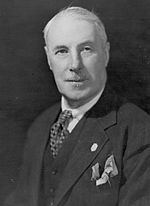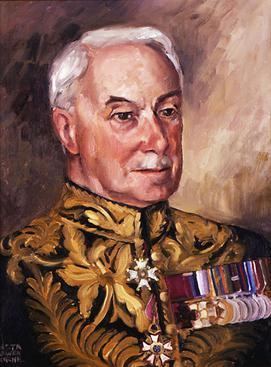Preceded by Alan Chambers | Role Canadian Politician Premier W.A.C. Bennett Name George Pearkes | |
 | ||
Governor General Georges VanierRoland Michener Died May 30, 1984, Victoria, Canada Similar People Thomas C Kinkaid, Yasuyo Yamasaki, Archibald Vincent Arnold, Simon Bolivar Buckner, Kakuji Kakuta | ||
Major General George Randolph Pearkes, (February 28, 1888 – May 30, 1984) was a Canadian politician and soldier. He was a recipient of the Victoria Cross, the highest award for gallantry in the face of the enemy awarded to British and Imperial forces; and the 20th Lieutenant Governor of British Columbia.
Contents
- Early life
- First World War and Victoria Cross
- Interbellum
- Second World War
- Political career
- Lieutenant governor and later life
- Family
- Legacy
- Honours and awards
- References

Early life
Born in Watford, Hertfordshire, England in 1888, the oldest child of Louise and George Pearkes, he attended Berkhamsted School. In 1906, he and his brother emigrated to Alberta where they settled near Red Deer. In 1911, George joined the North-West Mounted Police and served in Yukon until the outbreak of the First World War.
First World War and Victoria Cross
In 1915, he enlisted in the Canadian Expeditionary Force 2nd Regiment, Canadian Mounted Rifles; transferring in September 1916 to the 5th Battalion Canadian Mounted Rifles. In the photo obtained from Library and Archives Canada (PA-002310) dated December 1917, Major Pearkes, 5th Canadian Mounted Rifles, is shown wearing the Military Cross service ribbon, but has not yet received the ribbon for the Victoria Cross. He is wearing 4 wound stripes on his sleeve.
Pearkes was 29 years old, and an acting major during the Battle of Passchendaele when the following deed took place for which he was awarded the Victoria Cross (VC):
For most conspicuous bravery and skilful handling of the troops under his command during the capture and consolidation of considerably more than the objectives allotted to him, in an attack. Just prior to the advance Major Pearkes was wounded in the thigh. Regardless of his wound, he continued to lead his men with the utmost gallantry, despite many obstacles.
At a particular stage of the attack his further advance was threatened by a strong point which was an objective of the battalion on his left, but which they had not succeeded in capturing. Quickly appreciating the situation, he captured and held this point, thus enabling his further advance to be successfully pushed forward.
It was entirely due to his determination and fearless personality that he was able to maintain his objective with the small number of men at his command against repeated enemy counter-attacks, both his flanks being unprotected for a considerable depth meanwhile.
His appreciation of the situation throughout and the reports rendered by him were invaluable to his commanding officer in making dispositions of troops to hold the position captured.
He showed throughout a supreme contempt of danger and wonderful powers of control and leading.
During the war, he was promoted to lieutenant colonel. Aside from the VC, Pearkes was awarded the Distinguished Service Order and the Military Cross.
Interbellum
Following the First World War he became a career officer in the army. He was appointed to Princess Patricia's Canadian Light Infantry. During the 1920s and early 1930s he was stationed as a staff officer in Winnipeg, Manitoba and in Calgary, Alberta. He also served as staff officer at the Royal Military College of Canada in Kingston, Ontario. In 1925 Pearkes married Constance Blytha Copeman and they had two children. In 1936, he attended the Imperial Defence College for two years.
From 1938 to 1940 he was District Officer Commanding 13th Military District in Calgary. With the opening of hostilities with Germany in the Second World War, Brigadier Pearkes was given command of the 2nd Canadian Infantry Brigade, a component of the 1st Canadian Infantry Division, which comprised a number of units raised in western Canada.
Second World War
In December 1939, Pearkes and his staff left for England where the 1st Division was finally concentrated in a single place as a formation. In February 1940 he developed a serious case of spinal meningitis, but soon recovered.
In November 1941 Pearkes was asked to assume temporary command of the expanding Canadian Corps, taking the place of Andrew McNaughton who was on an extended leave. General Bernard Montgomery of the British Army, whose opinions of Canadian officers were crucial in the careers of senior officers overseas in the mid-war period, felt that Pearkes was a "gallant soldier" with "little brains".
In August 1942 Pearkes was returned to Canada and became General Officer Commanding in Chief Pacific Command, primarily a home defence organization for western Canada. He oversaw defences on Canada's West Coast.
In 1943 Pearkes was part of the planning for Operation Greenlight, retaking the Aleutian Islands from the Japanese.
During the Second World War, in 1944, Pearkes was instrumental in suppressing the Terrace Mutiny, a revolt by conscripts stationed in Terrace, British Columbia resulting from the announcement that conscripts would be deployed overseas. Although successful, Pearkes was extremely critical of the actions that led to it in the first place, stating he had been placed in the "intolerable position of being ordered to enforce a policy which his past experience gained in applying similar policies has proven ruinous to discipline of [troops], and of being in an utterly dishonourable position, and [Pearkes said] that he will NOT issue instructions to his [junior commanders] placing them in an impossible situation."
When it became clear that the government was not considering deploying troops for the fighting in the Pacific, Pearkes requested a change of command, or to be allowed to retire. The Cabinet War Committee eventually decided on the latter, and he retired from the Army in February 1945. He went into federal politics, winning the Nanaimo, British Columbia riding for the Progressive Conservative Party.
Political career
In the 1945 federal election, he was elected as a Progressive Conservative Party candidate in the riding of Nanaimo, British Columbia. He was re-elected in 1949. In the 1953 election, he was elected in the riding of Esquimalt—Saanich, British Columbia. He was re-elected in the 1957 and 1958 elections.
He was Minister of National Defence from 1957 to 1960 under Prime Minister John Diefenbaker. In 1958, Pearkes recommended that the Avro Arrow programme be cancelled. In a historic turning point for Canadian aviation, the costly programme was cancelled in 1959 in favour of a less costly alliance on missile defense with NORAD. He resigned from federal politics in 1960.
Lieutenant governor and later life
He became Lieutenant Governor of British Columbia on October 13, 1960, and became one of the few Lieutenant Governors to agree to an extended term, serving until July 1968.
In 1967, he was made a Companion of the Order of Canada. Parkes died on May 30, 1984 in Victoria, British Columbia, and is commemorated at the Holy Trinity Cemetery, West Saanich, Sidney, Victoria, British Columbia, Canada. Section 4 – West. His Victoria Cross is displayed at the Canadian War Museum in Ottawa.
Family
In August 1925, he married Constance Blytha Copeman. A daughter, Priscilla Edith ("Pep"), was born in 1928 though she died while still a young child. A son, John Andre, was born in 1931.
Legacy
Pearkes' name has been honoured in various ways, including:
He donated a ceremonial sword to Berkhamsted School to be awarded each year to the school's best senior NCO cadet.
Honours and awards
Major General George Pearkes received numerous awards during his life these include
He was sworn in as a Member of the Queen's Privy Council for Canada on June 21, 1957. This gave Him the right to use the honorific prefix "The Honourable" and the post nominal letters "PC" for life.
He Received the Key to the City of
He Received the Freedom of the City of
[2]
He received honorary degrees from many universities including
